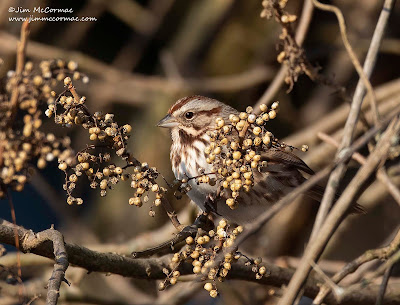Poison Ivy (Toxicodendron radicans), in autumn color. Just saying its name usually triggers negative reactions. This beautiful native species is among the most despised members of our flora. It does contain urushiol, the active compound that causes blistering dermatitis among those who are allergic to it (and that's most people).
Ironically, we (people) are the cause for the abundance of this opportunistic winner. Poison Ivy is a successional species, thriving in disturbed habitats. And we've created no shortage of disturbances in which it can thrive. It would be interesting to beam back to pre-settlement North America to see what Poison Ivy's status was then. My hunch: not nearly so common, and mostly confined to areas of natural disturbances.
A Yellow-rumped Warbler (Setophaga coronata) snacks on the yellowish-white berries of Poison Ivy. This hardy warbler winters as far north as the northern states in the eastern U.S. The abundance of Poison Ivy and its copious fruit are a major reason why - maybe THE primary reason. Yellow-rumps become highly frugivorous in late fall and winter, and really go for these berries. Birds, obviously, are not susceptible to urushiol's toxicity. Indeed, I wonder if any non-Homo sapiens animals are.While exploring a central Ohio park the other day, big camera rig in hand, I was pleased to come across a large mixed foraging flock of birds. I heard the chips of Yellow-rumped Warblers from afar, and saw many American Robins, a few Northern Flickers, and other species. As I slowly moved in, I saw the reason for the flock: a number of trees draped with vines of Poison Ivy heavily laden with fruit.
Awesome! I love coming across such a situation in winter, as - from just a photography perspective - it means the potential for lots of interesting shots. From a bird-watcher's perspective, the ivy-attracted birds mean lots of interesting observations. Sure enough, in the hour or so I stood quietly watching and photographing, a Cooper's Hawk made a pass through, and a young Red-shouldered Hawk did the same. The former cleared everyone out, and it took about fifteen minutes for the situation to rebound. The latter had little impact on the birds' behavior. They know that the comparatively slow and clumsy Buteo has little chance of bagging a small speedy songbird.
A Song Sparrow (Melospiza melodia) among an ocean of fruit. It plucked and downed many. While Yellow-rumped Warblers are conspicuous, frequently give their distinctive tchek! calls, and often forage higher in the vines, the sparrows typically remain low and feed quietly.
I saw a number of other species grabbing Poison Ivy berries, but couldn't get shots. There are dozens of potential candidates that might snack on the fruit. I have even seen giant Pileated Woodpeckers (Dryocopus pileatus) hanging agilely from the vines, pulling off berries.
The sheer number of fruit in this particular Poison Ivy honey hole means that the site should be productive for some time to come, and I look forward to returning, camera in hand.




No comments:
Post a Comment